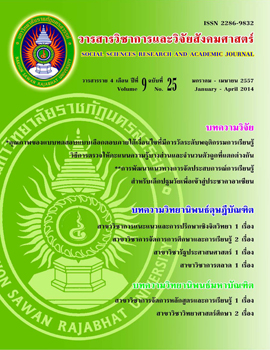ผลการสอนโดยใช้วัฏจักรการเรียนรู้ด้วยเทคนิคการเรียนแบบร่วมมือ ที่มีต่อผลสัมฤทธิ์ทางการเรียนและเจตคติต่อวิชาวิทยาศาสตร์ ของนักเรียนชั้นประถมศึกษาปีที่ 5
Main Article Content
Abstract
บทคัดย่อ
การวิจัยครั้งนี้เป็นการวิจัยเชิงทดลองเบื้องต้นมีวัตถุประสงค์เพื่อ 1) ศึกษาจำนวนนักเรียนที่ได้รับการสอนโดยใช้วัฏจักรการเรียนรู้ด้วยเทคนิคการเรียนแบบร่วมมือ ที่มีผลสัมฤทธิ์ทางการเรียนผ่านเกณฑ์ร้อยละ 70 2) เพื่อเปรียบเทียบผลสัมฤทธิ์ทางการเรียนวิชาวิทยาศาสตร์ก่อนและหลังเรียนโดยใช้วัฏจักรการเรียนรู้ด้วยเทคนิคการเรียนแบบร่วมมือ และ 3) เพื่อเปรียบเทียบเจตคติต่อวิชาวิทยาศาสตร์ก่อนและหลังเรียนของนักเรียนที่ได้รับการสอนโดยใช้วัฏจักรการเรียนรู้ด้วยเทคนิคการเรียนแบบร่วมมือ เครื่องมือที่ใช้ในการวิจัย ได้แก่ 1) แผนการสอนเรื่อง เสียงและการได้ยิน 2) แบบทดสอบวัดผลสัมฤทธิ์ทางการเรียนวิชาวิทยาศาสตร์ เรื่อง เสียงและการได้ยิน ซึ่งเป็นแบบเลือกตอบ 4 ตัวเลือก มีความยากง่ายระหว่าง .20 - .75 อำนาจจำแนกระหว่าง .31-.69 และความเที่ยง 0.92 และ 3) แบบวัดเจตคติต่อวิชาวิทยาศาสตร์ เป็นมาตราส่วนประมาณค่า 5 ระดับ กลุ่มตัวอย่างที่ใช้ในการวิจัย ได้แก่ นักเรียนชั้นประถมศึกษาปีที่ 5 โรงเรียนบ้านวังกระโดนใหญ่ จำนวน 21 คน ซึ่งได้จากการสุ่มอย่างง่าย สถิติที่ใช้ คือ การทดสอบไคสแควร์ และการทดสอบอันดับที่มีเครื่องหมายกำกับของวิลคอกสัน
ผลการวิจัยมีดังนี้
1. นักเรียนที่ได้รับการสอนโดยใช้วัฏจักรการเรียนรู้ด้วยเทคนิคการเรียนแบบร่วมมือมีคะแนนผลสัมฤทธิ์ทางการเรียนผ่านเกณฑ์ร้อยละ 70 ของคะแนนเต็ม มีจำนวนนักเรียนผ่านเกณฑ์จำนวน 17 คน คิดเป็นร้อยละ 80.95 ของจำนวนนักเรียนทั้งหมด
2. นักเรียนที่ได้รับการสอนโดยใช้วัฏจักรการเรียนรู้ด้วยเทคนิคการเรียนแบบร่วมมือมีผลสัมฤทธิ์ทางการเรียนวิชาวิทยาศาสตร์หลังเรียนสูงกว่าก่อนเรียนอย่างมีนัยสำคัญทางสถิติที่ระดับ .05
3. นักเรียนที่ได้รับการสอนโดยใช้วัฏจักรการเรียนรู้ด้วยเทคนิคการเรียนแบบร่วมมือมีเจตคติต่อวิชาวิทยาศาสตร์หลังเรียนสูงกว่าก่อนเรียนอย่างมีนัยสำคัญทางสถิติที่ระดับ .05
Abstract
The purposes of this research were to 1) to study the number of Prathomsuksa 5 students taught by learning cycle with cooperative learning technique passing the achievement criterion of 70%, 2) to compare the academic achievement in Science of the students who were taught using learning cycle with cooperative learning technique between before and after learning, and 3) to compare the attitudes towards science before and after learning of students who were taught by learning cycle with cooperative learning technique.
This research was a pre-experimental research. The research tools were composed of 1) the six lesson plans, 2) the achievement test having a multiple choice test with 4 options of 32 items with content validity and degree of difficulty between .20 to .75, discrimination power between .31 to .69 and reliability coefficient of 0.92, and 3) the attitude tests towards Science having five degrees of rating scales.
The samples used in this study were 21 students in Prathomsuksa 5 at Banwangkradoneyai School. They were enrolled in the second semester of the academic year 2013, and were selected by simple random sampling.
The results were as follows:
1. 17 people or 80.95 percent of the total number of students had academic achievement in science after being taught using learning cycle with cooperative learning technique passing 70 percent of the total score.
2. The student’s academic achievement in science taught using learning cycle with cooperative learning technique was higher than before learning at the .05 level of statistical significance.
3. The student’s attitude towards science taught using learning cycle with cooperative learning technique was higher than before learning at the .05 level of statistical significance.


